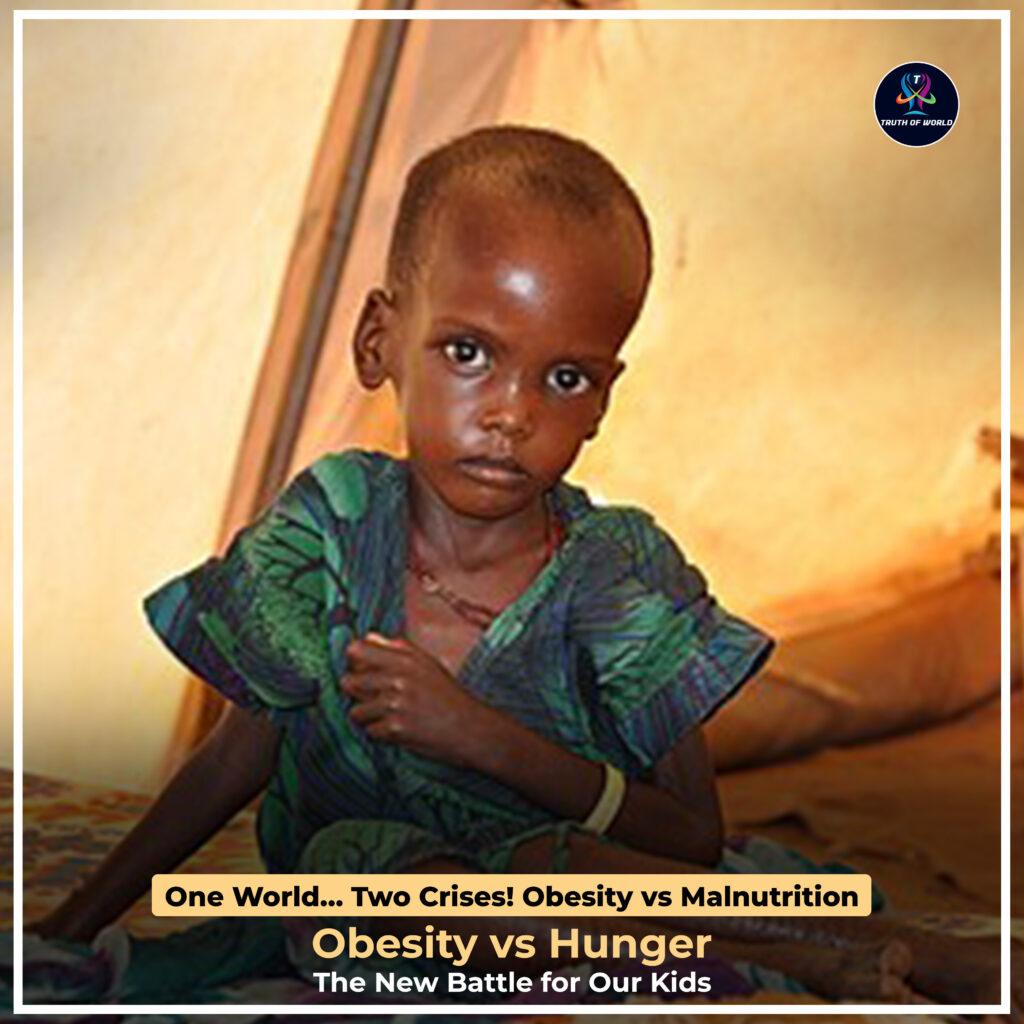In today’s rapidly changing world, children’s health has become a global concern. For decades, malnutrition was considered the greatest threat to child survival in developing nations. However, for the first time in history, childhood obesity has surpassed undernutrition in prevalence among the world’s young population.
According to the World Health Organization (WHO) and UNICEF, this shift marks not just a statistical change, but a fundamental transformation in how societies are feeding and raising the next generation. On one side of the globe, millions of children still struggle with hunger and nutrient deficiencies. On the other side, rising affluence, fast food culture, and sedentary lifestyles are fueling an epidemic of obesity.
This double burden paints a complex and often painful picture of inequality, modernization, and health systems under stress.
The Global Landscape: Obesity vs Malnutrition
The global numbers highlight a paradox: both problems exist simultaneously, sometimes within the same communities or even within the same households.
- In Sub-Saharan Africa and parts of rural Asia, undernutrition remains a critical issue. Millions of children are stunted, underweight, or suffering from micronutrient deficiencies.
- In North America, Europe, and the Middle East, childhood obesity has skyrocketed in the last three decades.
- In South Asian countries like India, Nepal, and Bangladesh, both challenges co-exist: children in poorer regions face hunger, while urban kids face obesity.
This coexistence of extremes reflects not only economic inequality but also the failures of food systems and lifestyle transitions.
Why is Childhood Obesity Rising?
Several interlinked factors explain why obesity has become such a dominant challenge among children:
- Processed and Fast Food Culture
Children today consume far fewer fruits, vegetables, and home-cooked meals. Instead, diets are dominated by sugary beverages, packaged snacks, and calorie-dense fast food. - Sedentary Lifestyle
Increased screen time — from online classes to video games — has dramatically reduced physical activity. The digital revolution has given rise to an inactive generation. - Urbanization and Convenience Culture
In urban areas, busy parents rely more on quick meals, ready-to-eat foods, or restaurant options, which are often unhealthy. - Lack of Awareness
Many parents don’t track their child’s BMI (Body Mass Index) or understand the importance of balanced nutrition. Obesity signs are often ignored until it becomes a serious issue. - Psychological and Social Factors
Stress eating, peer influence, and social media advertising contribute to unhealthy food choices among children.
Why Does Malnutrition Still Exist?
Despite the obesity epidemic, malnutrition hasn’t disappeared. In fact, it remains a silent crisis for millions.
- Poverty and Inequality – Families in marginalized regions cannot access or afford nutrient-rich foods.
- Micronutrient Deficiency – Children may eat enough calories but still lack essential nutrients such as iron, vitamin D, and zinc.
- Weak Health Infrastructure – Rural areas lack regular growth monitoring, supplements, and health education.
- Awareness Gaps – Parents often fail to recognize the signs of malnutrition until it’s too late.
This reveals that food availability alone doesn’t guarantee nutrition — quality, diversity, and accessibility are equally important.
The Health Risks on Both Sides
Whether it’s obesity or malnutrition, both conditions pose severe long-term health risks:
- Obesity Risks:
Type 2 diabetes, hypertension, cardiovascular disease, hormonal imbalances, low self-esteem, and even depression. - Malnutrition Risks:
Stunted growth, weak immunity, frequent infections, delayed brain development, learning difficulties, and higher child mortality.
The alarming truth is that both extremes undermine not only children’s health but also a nation’s economic and social future.

The Scientific Perspective
Nutrition science emphasizes that children require a daily balance of macronutrients (carbohydrates, protein, fats) and micronutrients (vitamins and minerals). When this balance is disrupted, the result is either:
- Calorie Surplus (leading to Obesity)
- Calorie Deficit (leading to Malnutrition)
Genetics and metabolism also play a role. Two children consuming similar diets may show completely different outcomes, depending on how their bodies process and store energy.
The Role of Parents and Schools
Tackling this crisis requires active involvement from families and schools:
- Parents must introduce healthy eating habits, encourage physical activity, and monitor screen time.
- Schools must ban junk food on campus and ensure nutritious mid-day meals or canteen options.
- Awareness Programs are vital to help children recognize healthy vs. unhealthy food choices themselves.
Policy Interventions: What Governments Are Doing
Several countries have already introduced policies to fight childhood obesity and malnutrition:
- Sugar Taxes: Imposing extra taxes on sugary drinks to discourage consumption.
- School Nutrition Programs: Providing free or subsidized healthy meals to children.
- Public Campaigns: Using TV, radio, and social media to spread health awareness.
- Nutrition Labels: Making it mandatory for packaged foods to display clear calorie and nutrition information.
In India, initiatives like Poshan Abhiyaan and the Mid-Day Meal Scheme have made progress, but implementation challenges remain.
The Way Forward
The road to solving this dual crisis lies in a balanced, multi-level approach:
- Address Both Extremes Together
Policymakers must not focus on just one side — obesity and malnutrition need equal attention. - Community Participation
Local NGOs, health workers, and youth groups should be empowered to spread awareness and support families. - Leverage Digital Platforms
Instead of fueling unhealthy habits, social media can be used to promote health education and positive peer influence. - Empower Parents and Teachers
Active monitoring and early interventions can prevent both undernutrition and obesity.
Children are the future of every nation, and their health determines the strength of tomorrow’s society. Ignoring the double burden of malnutrition — obesity on one hand and undernutrition on the other — would be catastrophic.
This shift is a warning bell: modernization, lifestyle changes, and inequality are reshaping childhood health across the globe. A world where one child suffers from hunger while another suffers from obesity is a world failing its future.
The solution lies in balanced nutrition, informed choices, strong policies, and collective action.
Ultimately, a healthy childhood means a healthy future. Addressing both childhood obesity and malnutrition together is not just a health priority — it is a moral responsibility.




